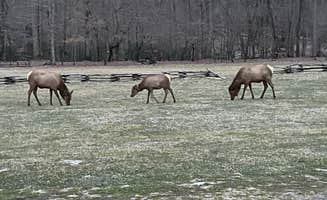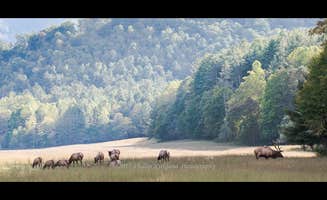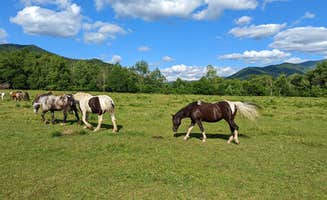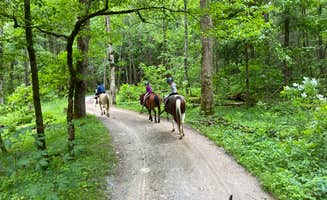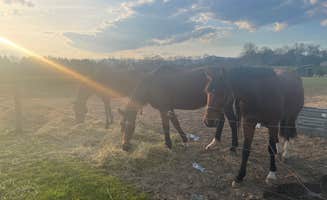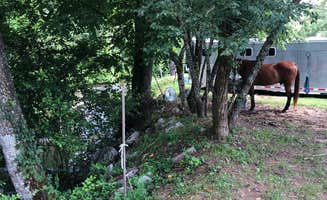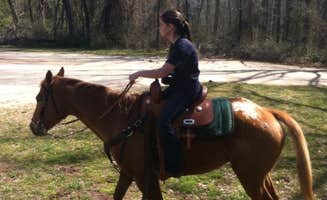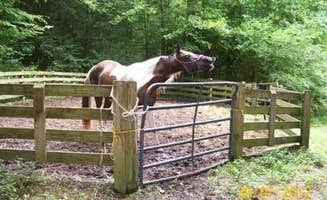Equestrian camping near Cherokee, North Carolina primarily relies on Tsali Campground in Whittier, located 14 miles southwest of Cherokee at an elevation of 1,900 feet. The area features diverse terrain with elevations ranging from 1,700 to 5,000+ feet across nearby camping options, creating significant temperature variations even in summer months. Trail access often requires navigating narrow, winding mountain roads with occasional gravel sections.
What to do
Mountain biking trails: Tsali Recreation Area features designated riding days for both horses and mountain bikes, with over 40 miles of trails. "This is a great example of just that, offering amenities for you to enjoy but proximity to easily drive to an adventure just ahead," notes one visitor at Tsali Campground.
Swimming and tubing: Cool off during hot summer months in nearby creeks and rivers. At Deep Creek Tube Center & Campground, a visitor shares, "You can put in your tube at one side of campground and float to end of tent sites to get out (15-20 minutes total float) or drive up the road a bit to Smoky Mountain Deep Creek entrance for a longer run of about 2-3 hours and end up back in camp."
Historic structures exploration: Visit preserved buildings throughout the region, including churches, schools and homesteads. "There are several historic structures in the area—a school, a church, barns, old houses, etc," explains a camper at Cataloochee Campground. Many sites preserve 19th-century mountain life with accessible walking paths.
What campers like
Creek-side sites: Waterfront camping spots provide natural white noise and cooler temperatures. A camper at Big Creek Campground shares, "The camp is beautiful and you are surrounded by the magical sounds of rushing water. There are two creeks nearby, one big and one small."
Wildlife viewing opportunities: Early mornings and evenings offer the best wildlife spotting times. "Early in the morning or late in the afternoon, you can drive about a mile, and sometimes less, to see elk and lots of them," writes a visitor to Cataloochee Campground. Wildlife sightings vary seasonally, with elk most active during fall rutting season.
Tent-specific areas: Some campgrounds cater specifically to tent campers with dedicated spaces. "The only tent-only campground in the GSMNP considered frontcountry. Well maintained sites and restroom area," writes a reviewer about Big Creek Campground, which features 12 tent sites with fire pits and lantern poles.
What you should know
Limited cell service: Most campgrounds in the mountains have spotty or non-existent coverage. "Limited cell service for AT&T," notes a camper at Tsali Campground. Verizon coverage tends to be slightly better but still inconsistent throughout the region.
Bear precautions required: All food must be properly stored in bear-proof containers or vehicles. A camper at Cataloochee Campground warns, "Be careful out there though, a black bear walked through our site while we were fixing dinner. Didn't bother us, but it was a nice little scare."
Remote access roads: Many campgrounds require driving on narrow, winding roads with limited passing areas. "It's a long 13 miles into the valley down a very narrow, curvy gravel road, so I wouldn't try w/o reservations!" explains a Cataloochee Campground visitor about the challenging drive.
Reservation requirements: Most campgrounds fill quickly, especially during summer and fall. "Reservations are highly recommended, but it is possible except on the busiest weekends to occasionally snag one of the not so prime sites," advises a Cataloochee visitor.
Tips for camping with families
Kid-friendly activities: Look for campgrounds with built-in entertainment options. One family camping at Cherokee Great Smokies KOA shares, "All kinds of stuff for the kids. Two pools, jump pillow and pad, banana bikes, play ground and three ponds for fishing."
Multi-generational accessibility: Choose locations with varying difficulty levels for activities. "If you like hiking, there are miles of hiking trails, especially since this campground is located in a national park," mentions a Cataloochee Campground visitor, noting the variety of trail difficulties available.
Morning wildlife tours: Plan early morning excursions specifically for wildlife viewing. "We spent 5 nights and watched them early am and afternoons every day," says a Cataloochee camper about elk viewing. Rangers often monitor popular viewing areas during peak season to ensure visitor safety.
Tips for RVers
Size restrictions: Many mountain campgrounds have limitations on RV length. "Access to Cataloochee is via a narrow, winding, mountain road. A 3-mile stretch of gravel road contains many narrow, blind curves. Though many campsites will accommodate large rigs, motorhomes over 32' and trailers over 25' in length are not recommended due to the access road," explains a review from Cades Cove Campground.
Full hookup options: Several campgrounds offer complete amenities for longer stays. "The spots have dedicated tent area, picnic tables and fire rings. Multiple bear proof trash cans and water spickets on both loops and easy to access," notes a Tsali Campground reviewer, highlighting the accessible amenities.
Weather preparedness: Mountain weather can change rapidly, affecting RV access and comfort. "We tent camped at an electric site and it was awesome. There's shelters to camp under, a fire ring, and a picnic table," explains a visitor at Deep Creek, mentioning the weather protection options.


